Table of Contents
Top 10 Madhubani Painting Artist | Madhubani Painting
What is Madhubani Painting?
Madhubani Painting, also known as Mithila painting, is a traditional art form that originated in the Mithila region of Bihar, India. It is one of the oldest forms of traditional Indian art and is characterized by its vibrant colors, intricate patterns, and depictions of nature, mythology, and daily life. The name “Madhubani” is derived from the Sanskrit words “Madhu,” meaning honey, and “Ban,” meaning forest, suggesting a land of honey.
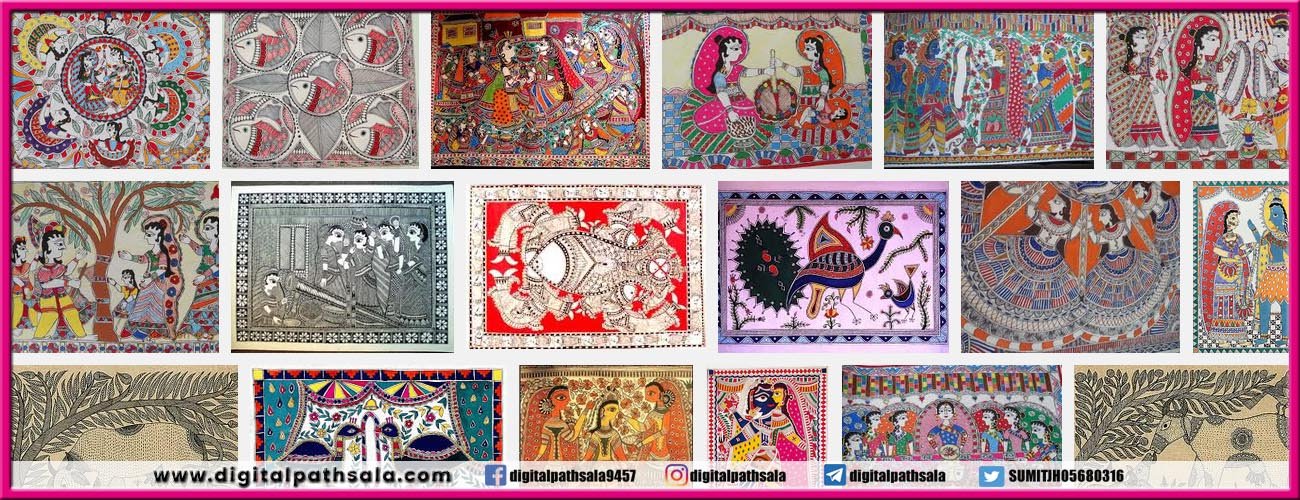
Key features of Madhubani Painting:
- Themes: Madhubani paintings often depict a range of themes, including religious and mythological stories, scenes from daily life, nature, and symbolic motifs. Common subjects include deities, animals, birds, and geometric patterns.
- Technique: Traditionally, Madhubani paintings are created using natural pigments and dyes. The artists use brushes, twigs, or even fingers to apply the colors. The paintings are known for their intricate detailing and the use of fine lines and patterns.
- Surfaces: Madhubani art can be found on various surfaces such as handmade paper, cloth, canvas, and even walls. Originally, it was done as wall art during festivals, weddings, and other special occasions.
- Styles: Different regions and communities within the Mithila region have developed distinct styles of Madhubani Painting. These styles often reflect the cultural and regional diversity of the area.
- Cultural Significance: Madhubani art has a deep cultural and social significance. Traditionally, women in the community would create these paintings as a form of expression and to decorate their homes during celebrations. Over time, it has evolved into a recognized art form with global appeal.
- Evolution: While Madhubani Painting has deep traditional roots, contemporary artists have also adapted the style to create more modern and innovative pieces. The art form has gained recognition not only in India but also internationally.
Top 10 Madhubani Painting Artist :
List of 10 notable Madhubani Painting artists who have made significant contributions to the art form are as follows :
- Jagdamba Devi
- Sita Devi
- Ganga Devi
- Mahasundari Devi
- Leela Devi
- Godavari Dutta
- Baua Devi
- Dulari Devi
- Shanti Devi
- Bharti Dayal
1. Jagdamba Devi :
Jagdamba Devi was a highly respected Madhubani Painting Artist known for her significant contributions to the art form. Born in the Mithila region of Bihar, India, in 1928, she played a pivotal role in popularizing Madhubani painting both nationally and internationally.
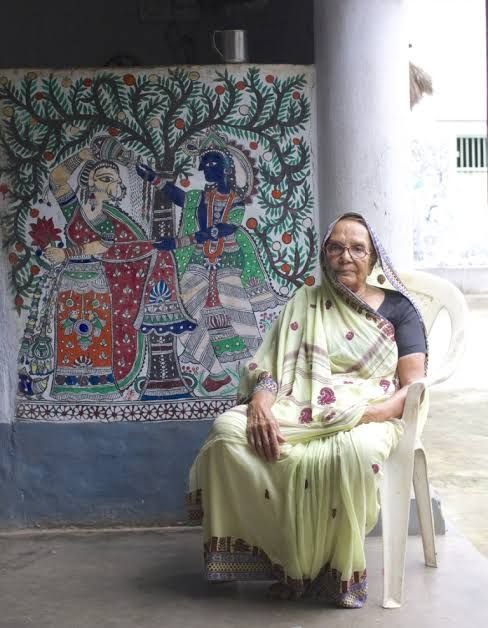
Here are some key points about Jagdamba Devi:
- Early Life and Background:
- Jagdamba Devi was born into a family with a rich tradition of Madhubani art. She grew up in the Mithila region, where the art form was an integral part of the cultural heritage.
- Artistic Journey:
- From a young age, Jagdamba Devi displayed a natural talent for Madhubani painting. She honed her skills by observing and learning from the artistic practices of her family and community.
- Pioneering Work:
- Jagdamba Devi’s work is characterized by intricate patterns, vibrant colors, and a deep connection to cultural and religious themes. She became a pioneer in the Madhubani art movement, contributing to the recognition and preservation of this traditional art form.
- Recognition and Awards:
- Jagdamba Devi’s talent and dedication to Madhubani art earned her widespread recognition. She received several awards for her contributions, including the National Award for Master Craftsperson, which she received from the President of India in 1975.
- Global Impact:
- Jagdamba Devi’s paintings gained international acclaim, contributing to the global recognition of Madhubani art. Her work was showcased in exhibitions and galleries worldwide, further establishing the art form on the international stage.
- Role in Community Development:
- Apart from her artistic pursuits, Jagdamba Devi actively contributed to the development of her community. She encouraged and mentored other artists, playing a key role in passing down the Madhubani art tradition to the younger generation.
- Legacy:
- Jagdamba Devi’s legacy extends beyond her own artistic achievements. She is remembered as a trailblazer who helped bring Madhubani painting to a broader audience, fostering appreciation for the cultural and artistic richness of the Mithila region.
2. Sita Devi :
Sita Devi was a highly acclaimed Madhubani Painting Artist who made significant contributions to the popularization and recognition of this traditional Indian art form. Her talent and skill played a crucial role in bringing Madhubani painting to national and international prominence.
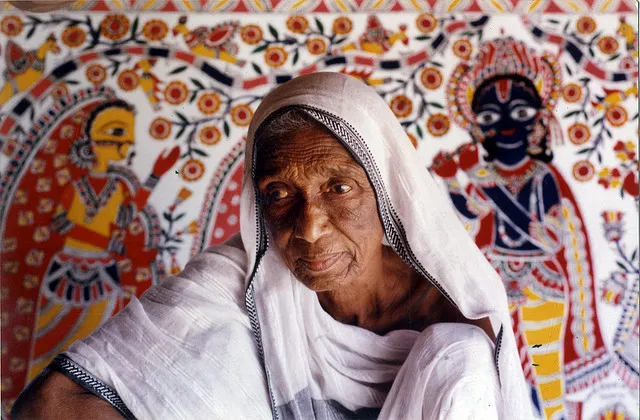
Here are some key points about Sita Devi:
- Early Life and Background:
- Sita Devi was born in 1914 in the village of Jitwarpur in the Mithila region of Bihar, India. The Mithila region is renowned for its rich cultural heritage and is the birthplace of Madhubani painting.
- Artistic Tradition:
- Sita Devi belonged to a family with a long-standing tradition of Madhubani art. She grew up in an environment where artistic skills were passed down through generations.
- Pioneering Madhubani Artist:
- Sita Devi is often referred to as the “Queen of Madhubani.” She played a pioneering role in establishing Madhubani painting as a recognized and celebrated art form.
- Early Recognition:
- Her artistic talents were noticed early on, and her work gained recognition locally. Sita Devi’s paintings were characterized by intricate detailing, vibrant colors, and a deep connection to traditional themes.
- National and International Acclaim:
- Sita Devi’s work received widespread acclaim, both nationally and internationally. Her paintings were showcased in various exhibitions and art galleries, contributing to the global recognition of Madhubani art.
- National Award:
- In 1969, Sita Devi was honored with the National Award for her exceptional contribution to Madhubani art. This recognition from the Indian government further solidified her status as a prominent artist.
- Legacy and Impact:
- Sita Devi’s legacy extends beyond her own artistic achievements. She played a crucial role in popularizing Madhubani painting beyond the boundaries of the Mithila region, influencing subsequent generations of artists.
- Mentorship and Community Development:
- Sita Devi actively mentored and encouraged other artists, contributing to the preservation and propagation of the Madhubani art tradition. Her contributions went beyond her individual work and had a positive impact on the community.
- Traditional Themes and Motifs:
- Sita Devi’s paintings often depicted traditional themes from Hindu mythology, nature, and daily life. She used symbolic motifs and intricate patterns to convey cultural narratives.
- Global Exhibitions:
- Sita Devi’s paintings were exhibited globally, contributing to the worldwide recognition of Madhubani art. Her work was showcased in international galleries, bringing attention to the rich artistic heritage of the Mithila region.
3. Ganga Devi :
Ganga Devi was a highly esteemed Madhubani Painting Artist known for her exceptional contributions to the world of Indian folk art. Born in the village of Mithila in Bihar, India, in 1928, Ganga Devi played a crucial role in popularizing Madhubani painting both within India and on the international stage.
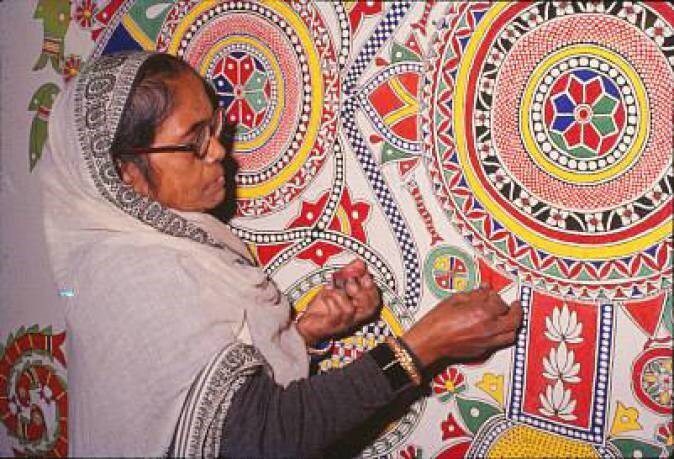
Here are some key points about Ganga Devi:
- Early Life and Artistic Roots:
- Ganga Devi was born into a family with a strong tradition of Madhubani art. The Mithila region, her birthplace, has been historically significant for this traditional art form.
- Traditional Upbringing:
- Growing up in a community where Madhubani art was an integral part of daily life, Ganga Devi learned the techniques and styles of this ancient art form from her family and community.
- Natural Talent:
- Ganga Devi displayed a natural talent for Madhubani painting from a young age. Her innate creativity and dedication to the art form contributed to her rapid development as an accomplished artist.
- Recognition and Awards:
- Ganga Devi’s artistic talents gained recognition, and she received several prestigious awards for her contribution to Madhubani art. In 1975, she was honored with the National Award for her outstanding work.
- International Recognition:
- Ganga Devi’s paintings gained international acclaim, leading to exhibitions in various countries. Her work played a significant role in introducing Madhubani art to a global audience and establishing it as a recognized form of Indian folk art.
- Themes and Motifs:
- Ganga Devi’s paintings often depicted themes from Hindu mythology, nature, and daily life. She skillfully used symbolic motifs, intricate patterns, and vibrant colors to convey cultural stories and traditions.
- Documentation and Teaching:
- Ganga Devi was not only a prolific artist but also played a role in documenting the traditional styles of Madhubani painting. She contributed to preserving the cultural heritage by teaching and mentoring younger artists in the community.
- Books and Publications:
- Ganga Devi authored books and publications on Madhubani art, contributing to the understanding and appreciation of the art form. Her writings provided insights into the cultural context, techniques, and symbolism in Madhubani painting.
- Legacy:
- Ganga Devi’s legacy lives on as one of the prominent figures in the Madhubani art movement. Her contributions helped elevate the status of Madhubani painting from a local tradition to a recognized and celebrated form of folk art globally.
- Impact on Contemporary Artists:
- Ganga Devi’s work has inspired many contemporary Madhubani artists. Her dedication to preserving and promoting the traditional art form has influenced subsequent generations, contributing to the continued vitality of Madhubani painting.
4. Mahasundari Devi :
Mahasundari Devi was a renowned Madhubani Painting Artist, known for her exceptional contributions to this traditional Indian art form. Born in 1927 in the village of Ranti in the Mithila region of Bihar, India, Mahasundari Devi played a significant role in popularizing Madhubani painting on both national and international platforms.

Here are some key points about Mahasundari Devi:
- Early Life and Artistic Background:
- Mahasundari Devi was born into a family with a rich tradition of Madhubani art. Growing up in the Mithila region, she was immersed in the cultural and artistic heritage of the community.
- Traditional Training:
- Like many Madhubani artists, Mahasundari Devi received her artistic training informally within her family and community. The traditional knowledge and techniques were passed down through generations.
- Recognition and Awards:
- Mahasundari Devi’s artistic talents gained recognition, and she received various awards for her contributions to Madhubani art. Her dedication and skill were acknowledged with honors such as the Bihar Ratna Award.
- Mythological Themes:
- Mahasundari Devi’s paintings often depicted themes from Hindu mythology. Her work featured scenes from epics like the Ramayana and the Mahabharata, portraying deities, celestial beings, and mythological narratives.
- Intricate Patterns and Detailing:
- Known for her intricate patterns and detailing, Mahasundari Devi’s paintings showcased the precision and skill characteristic of Madhubani art. She used fine lines and vibrant colors to bring her compositions to life.
- Global Recognition:
- Mahasundari Devi’s work gained international acclaim, contributing to the global recognition of Madhubani art. Her paintings were exhibited in various countries, helping to establish Madhubani painting as a respected form of Indian folk art worldwide.
- Role in Community Development:
- Beyond her individual contributions, Mahasundari Devi actively participated in community development. She mentored and encouraged younger artists, contributing to the preservation and propagation of Madhubani art within her community.
- Literary Contributions:
- Mahasundari Devi authored books and articles on Madhubani art, providing insights into the cultural and artistic aspects of the traditional form. Her writings contributed to the documentation and understanding of Madhubani painting.
- Legacy:
- Mahasundari Devi left behind a lasting legacy as one of the prominent figures in the Madhubani art movement. Her impact on the art form and her role in its global recognition continue to influence contemporary Madhubani artists.
- Cultural Ambassador:
- Mahasundari Devi, through her art and advocacy, became a cultural ambassador, helping to showcase the richness and diversity of Mithila’s cultural heritage to a wider audience.
5. Leela Devi :
Leela Devi was a renowned Madhubani Painting Artist, known for her exceptional contributions to this traditional Indian art form.Born on 15th January 1954 in village Chichri of district Madhubani in Bihar. She had studied till class seven and was married to Shri Umesh Nandan Lal Das of village Rashidpur. In 1976 in Rashidpur she had started learning Mithila painting from Late Smt. Ganga Devi who was a pioneer of traditional Mithila paintings.

In 1985 she got Bihar state award and in 1987 National Award for Master craftsperson. She makes pen drawings and paintings with natural colours. Her favorite subjects are religious, stories, Kohbar and Aripan. Her works were displayed at various places in India and in Japan.
Here are some key points about Leela Devi:
- Birth and Early Life:
- Leela Devi was born on January 15, 1954, in the village of Chichri in the Madhubani district of Bihar.
- Educational Background:
- She pursued her education until class seven, reflecting the traditional educational opportunities available during that time.
- Marriage and Family:
- Leela Devi was married to Shri Umesh Nandan Lal Das from the village of Rashidpur.
- Introduction to Mithila Painting:
- In 1976, while in Rashidpur, Leela Devi embarked on her journey to learn Mithila painting.
- Mentorship under Ganga Devi:
- Her initiation into Mithila painting began under the guidance of Late Smt. Ganga Devi, a pioneering figure in the realm of traditional Mithila paintings. Ganga Devi was renowned for her contributions to the art form.
- Traditional Mithila Painting:
- Leela Devi delved into the intricacies of traditional Mithila painting, which often involves vibrant colors, intricate patterns, and the depiction of themes from mythology, nature, and daily life.
- Role of Ganga Devi:
- Ganga Devi, as Leela Devi’s mentor, likely played a crucial role in shaping her artistic skills and understanding of the cultural and traditional aspects of Mithila painting.
- Artistic Journey:
- Leela Devi’s artistic journey began under the tutelage of Ganga Devi, and her experiences during this period likely influenced her own unique style within the Mithila painting tradition.
6. Godavari Dutta :
Godavari Dutta was a renowned Madhubani Painting Artist, known for her exceptional contributions to this traditional Indian art form.Born in the mid-1920 in Bahadurpur village, Darbhanga district, Bihar.she was taught mithila painting by her mother, Subhadra Devi, who herself was an artist. At only 10 years old Dutta lost her father. Together with her three siblings she was brought up by her mother.
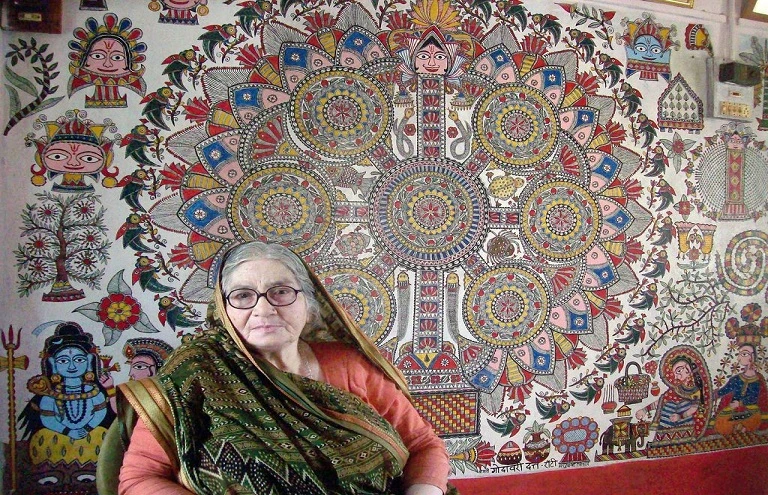
Here are some key points about Godavari Dutt:
- Birth and Early Life:
- Godavari Dutt was born in the mid-1920s in Bahadurpur village, Darbhanga district, Bihar, India.
- Family Background:
- Her mother, Subhadra Devi, was also an artist, indicating that Godavari Dutt was exposed to the world of Madhubani painting from an early age within her own family.
- Artistic Education:
- Godavari Dutt received her early education in painting from her mother, Subhadra Devi. This suggests a familial tradition of passing down the art form from one generation to the next.
- Loss of Father:
- At the age of 10, Godavari Dutt experienced the loss of her father. Despite this challenge, she, along with her three siblings, was brought up by her mother, Subhadra Devi.
7. Baua Devi :
Baua devi was a renowned Madhubani Painting Artist, known for her exceptional contributions to this traditional Indian art form.Born in 1940 in Jitwarpur village of Madhubani District in Bihar.She is the only Mithila artist to be included in the ground breaking show ”Magicians of the Earth” at Centre Pompidou (Paris) in 1988.
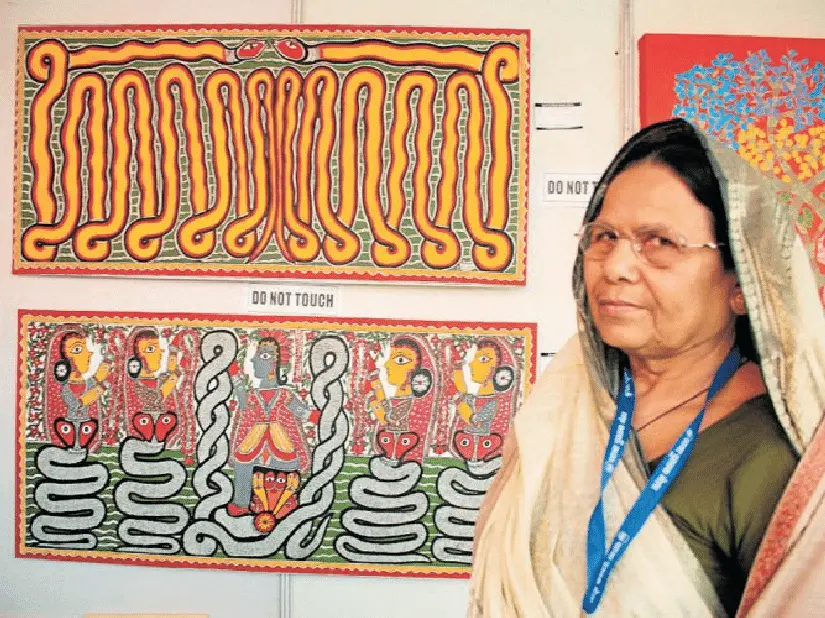
Here are some key points about Baua Devi:
- Acclaimed Madhubani Artist:
- Baua Devi is recognized as an accomplished Madhubani artist known for her skillful use of traditional motifs and vibrant colors. Madhubani art is celebrated for its intricate patterns, cultural themes, and the use of natural pigments.
- Skillful Use of Traditional Motifs:
- Baua Devi’s artistic style involves a skillful application of traditional Madhubani motifs. These motifs often include elements inspired by nature, mythology, and cultural symbols specific to the Mithila region.
- Vibrant Colors:
- One of the hallmarks of Madhubani art is the use of vibrant and contrasting colors. Baua Devi, like other Madhubani artists, likely employs a rich color palette to create visually striking and expressive artworks.
- Recognition for Contributions:
- Baua Devi has received recognition for her contributions to the Madhubani art form. This acknowledgment could be in the form of awards, exhibitions, or other honors within the artistic community.
8. Dulari Devi :
Dulari Devi was a renowned Madhubani Painting Artist, known for her exceptional contributions to this traditional Indian art form.She was born on 16 April 1970 in Brahmapuri, Sarlahi.In 2021, she was a recipient of the Padma Shri, a civilian honour granted by the Government of India, for her contributions to art.
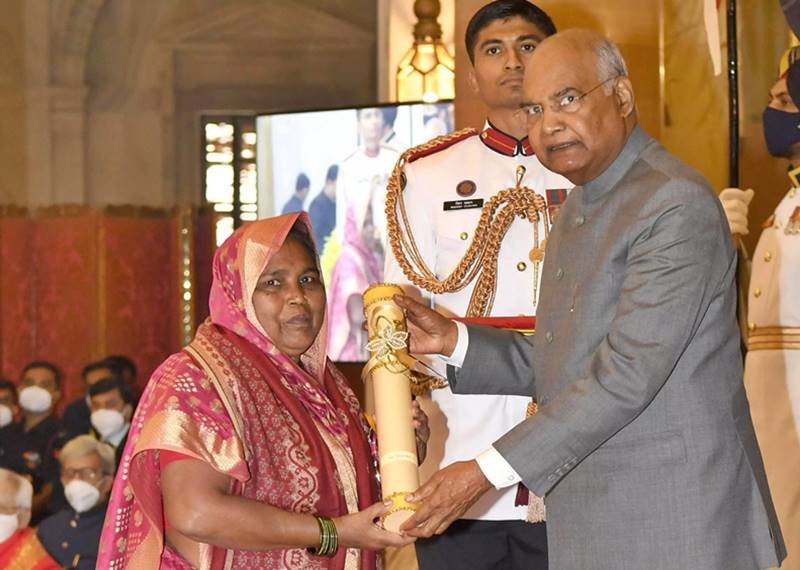
Here are some key points about Dulari Devi:
- Birth and Early Life:
- Dulari Devi was born on April 16, 1970, in Brahmapuri, Sarlahi.
- Artistic Background:
- She is known for her contributions to Madhubani art, a traditional form of folk art that originates from the Mithila region in Bihar, India.
- Padma Shri Recipient (2021):
- In 2021, Dulari Devi was honored with the Padma Shri, one of the highest civilian honors in India. This recognition by the Government of India underscores her significant contributions to the field of art.
- Contribution to Art:
- The Padma Shri award reflects Dulari Devi’s outstanding achievements and impact on the art world, particularly in the context of preserving and promoting Madhubani art.
- Recognition and Prestige:
- The Padma Shri is a prestigious award that recognizes individuals who have excelled and made notable contributions in various fields, including art and culture. Dulari Devi’s receipt of this honor places her among distinguished individuals in the artistic community.
- Cultural Preservation:
- Madhubani art is deeply rooted in the cultural heritage of the Mithila region. Dulari Devi, through her artistic endeavors, likely played a significant role in preserving and promoting this traditional art form.
- National and International Impact:
- The recognition with the Padma Shri suggests that Dulari Devi’s influence extends beyond regional boundaries, impacting the national and potentially international appreciation of Madhubani art.
9. Shanti Devi :
Shanti Devi is a renowned Madhubani Painting Artist, known for her exceptional contributions to this traditional Indian art form.Born in a small village Seema Gram in Madhubani district of Bihar.Shanti Devi practiced art for over 40 years and received several awards for her work, including the State Award in 1979, National Tamrapatra Award in 1984, Ashok Chakra in 1985, and Chetna Samiti Awards in 1993 and Padma Shri in 2024.
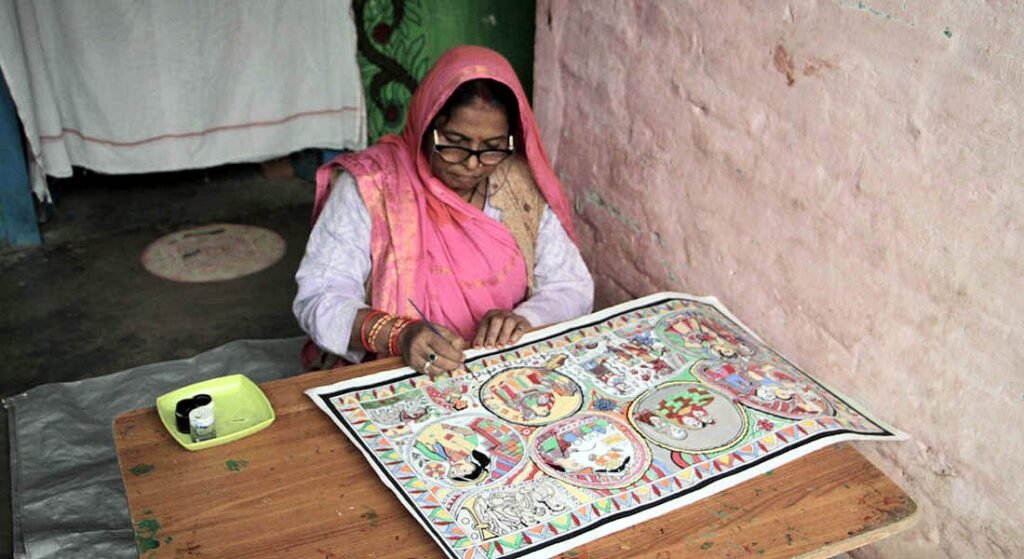
Here are some key points about Shanti Devi:
- Early Life: Shanti Devi was born in the quaint village of Seema Gram in the Madhubani district of Bihar, India.
- Artistic Journey: She dedicated over 40 years of her life to the practice of art, showcasing her immense passion and commitment to the field.
- Geographical Influence: Hailing from Madhubani, her art was deeply rooted in the cultural and traditional aesthetics of the region, contributing to the rich heritage of Madhubani art.
- Awards and Recognition: Shanti Devi’s exceptional artistic skills were acknowledged with numerous awards. Notable among them are the State Award in 1979, National Tamrapatra Award in 1984, Ashok Chakra in 1985, and Chetna Samiti Awards in 1993.
- State Award (1979): This recognition highlighted her significant contributions at the state level, acknowledging her talent and impact on the local art scene.
- National Tamrapatra Award (1984): The National Tamrapatra Award showcased her art’s national significance, signifying her outstanding contribution to the broader Indian artistic landscape.
- Ashok Chakra (1985): The Ashok Chakra is a prestigious honor, reflecting her exceptional talent and the positive influence her art had on society.
- Chetna Samiti Awards (1993): This recognition further underlines her sustained commitment to her craft and the lasting impression her art left on the community.
- Cultural Legacy: Shanti Devi’s work not only earned her awards but also contributed significantly to the cultural legacy of Madhubani art, preserving and promoting the traditional art form.
- Inspiration for Future Generations: Through her decades-long artistic journey and the accolades she received, Shanti Devi serves as an inspiration for aspiring artists, leaving behind a legacy that continues to influence and shape the world of Madhubani art.
10. Bharti Dayal :
Bharti Dayal was a renowned Madhubani Painting Artist, known for her exceptional contributions to this traditional Indian art form.Born in 1961 in Darbhanga District in Bihar.She pursued the art form professionally from 1984. She has worked to bring innovation in the traditional art practiced in Mithila, and train other women artists from the region at her studio in New Delhi.
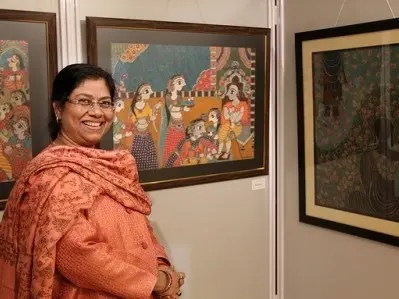
Here are some key points about Bharti Dayal:
- Birth and Early Life: Bharti Dayal was born in 1961 in Darbhanga District in Bihar, India, providing her with a cultural foundation rooted in the Mithila region, known for its rich artistic heritage.
- Professional Beginnings: Bharti Dayal embarked on her professional journey in the realm of Madhubani art from the year 1984, signifying her commitment to the art form.
- Innovations in Madhubani Art: Known for her innovative approach, Bharti Dayal has brought fresh perspectives and contemporary elements to the traditional Madhubani art, showcasing the evolution and adaptability of this ancient form.
- Training and Mentorship: Beyond her own artistic pursuits, Bharti Dayal has played a pivotal role in training and mentoring other women artists from the Mithila region. Her contributions extend to the empowerment of women through skill development and artistic expression.
- Studio in New Delhi: Bharti Dayal’s studio in New Delhi serves as a hub for creativity and learning. This space not only houses her own artistic endeavors but also functions as a platform for training and nurturing the talents of aspiring artists from the Mithila region.
- Cultural Exchange: Through her work in New Delhi, Bharti Dayal has contributed to cultural exchange by bringing the traditional Madhubani art closer to urban audiences and creating a bridge between rural artistic traditions and contemporary art scenes.
- Contribution to Women’s Empowerment: By focusing on training and empowering women artists, Bharti Dayal has made a meaningful contribution to gender empowerment in the field of Madhubani art, fostering a sense of independence and recognition for women artists from the Mithila region.
- Artistic Impact: Bharti Dayal’s artistic impact extends beyond the canvas, influencing the trajectory of Madhubani art by blending tradition with innovation and ensuring its relevance in contemporary artistic discourse.
- Recognition and Awards: If Bharti Dayal has received any awards or recognition for her contributions to Madhubani art and women’s empowerment, those achievements would further underscore her significance in the artistic community.
- Legacy: Through her multifaceted contributions, Bharti Dayal is leaving a lasting legacy in the world of Madhubani art, bridging tradition and modernity while fostering the growth of new generations of artists.
| Mithila Panchang 2023-24 PDF | Download Now |
| Vivah Din 2024 | Click Here |
| Dwiragaman Din 2024 | Click Here |
| Panchak 2024 | Click Here |
| Upnayan and Mundan Din 2024 | Click Here |
| Gharvas Din 2024 | Click Here |
| Top 10 Mithila Painting January 2024 | Click Here |
| Top 10 Tila Sankranti Maithili Geet | Click Here |
| Madhubani Painting Artists Awarded Padma Shri |
Click Here |
FAQ :
1. What is Madhubani Painting?
Madhubani painting, also known as Mithila art, is a traditional folk art form originating from the Mithila region of Bihar, India. It is characterized by vibrant colors, intricate patterns, and depictions of mythological themes, nature, and daily life.
2. What are the Origins of Madhubani Painting?
Madhubani painting has ancient roots, dating back to the times when women in the Mithila region adorned the walls of their homes with intricate designs during festivals and special occasions. Over the years, it has evolved into a distinct art form.
3. What Materials are Used in Madhubani Painting?
Traditionally, Madhubani artists use natural pigments and dyes derived from plants and minerals. The canvas is often prepared by coating it with a layer of cow dung and mud to provide a smooth base for the artwork. In contemporary times, artists may also use paper and fabric.
4. What are the Main Themes in Madhubani Painting?
Madhubani paintings often depict scenes from Hindu mythology, rituals, nature, and daily life. The themes can range from religious stories to symbolic representations of fertility, love, and prosperity.
5. Who Practices Madhubani Art?
Originally a women-centric art form, Madhubani painting was passed down through generations from mothers to daughters. In recent times, both men and women, including professional artists, have embraced and expanded the practice.

